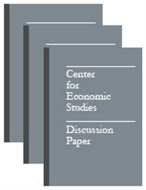The Work Disincentive Effects of the Disability Insurance Program in the 1990s
The Work Disincentive Effects of the Disability Insurance Program in the 1990s
Abstract
In this paper we evaluate the work disincentive effects of the Disability Insurance program during the 1990s. To accomplish this we construct a new large data set with detailed information on DI application and award decisions and use two different econometric evaluation methods. First, we apply a comparison group approach proposed by John Bound to estimate an upper bound for the work disincentive effect of the current DI program. Second, we adopt a Regression-Discontinuity approach that exploits a particular feature of the DI eligibility determination process to provide a credible point estimate of the impact of the DI program on labor supply for an important subset of DI applicants. Our estimates indicate that during the 1990s the labor force participation rate of DI beneficiaries would have been at most 20 percentage points higher had none received benefits. In addition, we find even smaller labor supply responses for the subset of ’marginal’ applicants whose disability determination is based on vocational factors.
Others in Series
Working Paper
Working Paper
Working Paper




